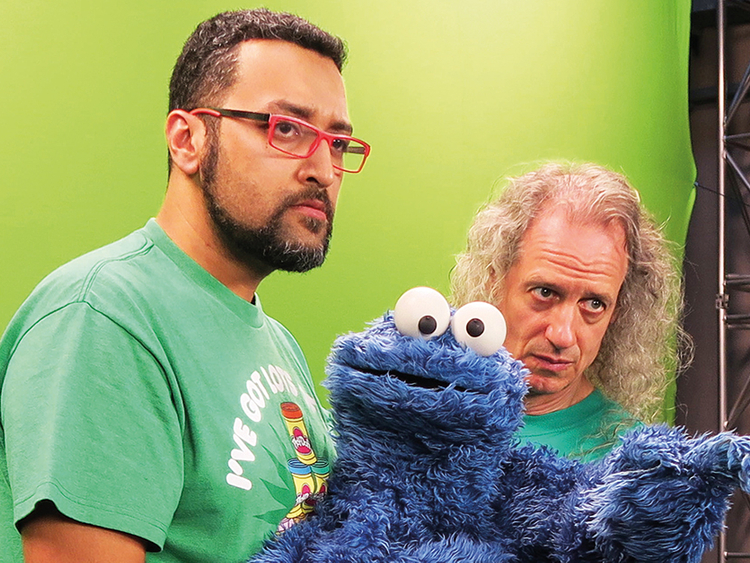
Jeddah: Ammar Aidarous Al Sabban had a lucrative job as an architect at a reputable firm in Jeddah — which he hated. And, when he felt that he could “no longer meet his full potential as an architect,” Al Sabban quit his job of 11 years to pursue his dream of becoming a puppeteer.
In Saudi Arabia, puppeteering is still an unknown art form.
“There are just a handful of Saudi puppeteers. A lot of people don’t know what it is, and those who know don’t accept it. Its an uphill battle for us,” he says.
The 39-year-old Saudi national told Gulf News that he wanted to be a puppeteer since he was a child.
“I remember I was only 5 years old and I wanted to become a cartoon character. I grew up watching Bugs Bunny and Sesame Street and I really wanted to be in that world,” he said.
Despite the passion, it was such an unconventional career path that Al Sabban never got around to pursuing it after high school.
In 2013, when Al Sabban’s wife, Dr. Bedour Essam, received a scholarship from King Abdullah University of Science and Technology (KAUST) to pursue a doctorate in chemistry, he decided it was the right time to try his luck at puppetry.
Al Sabban, who was already bored and unhappy with his job, took the opportunity to quick his day job, in order to focus on his passion and stay home with the couple’s three children.
The couple gave themsevles a three-year windown during which Essam would finish her doctorate and Al Sabban could puruse a career in pupptetry.
“If by the end of three years it didn’t work out, I would go back to architecture,” Al Sabban said.
He credited his wife for always supporting and believing in his dream where others did not see how such a career could be lucrative—even his parents.
While he eventually succeeded, it was a bumpy road to get there.
Since the puppetry market did not exist in Saudi Arabia, Al Sabban had to create work for himself.
He watched YouTube and behind-the-scene videos online to learn the ropes of puppeteering.
He then bought muppets from the market and released a four show episodes on YouTube which did not really gain traction.
He also applied to be a puppeteer on “Iftah Ya Simsim” (Arabic version of Sesame Street) at Bidaya Media in Abu Dhabi but was not chosen.
Time was not in his favour, but Al Sabban was nowhere near to giving up.
“It was a passion that I really wanted to do. Even when things got worse financially I knew I wanted to do it,” he said.
Al Sabban decided to travel to San Francisco and New York to train with some of Sesame Street’s master puppeteers.
“The sessions were grueling but I came back with more knowledge and practice. I was mentored by Marty Robinson and Frank Cas, and now I’m trying to follow their footsteps in the Arab world,” he said.
Al Sabban also learned how to make muppets at home by watching YouTube tutorials.
He created several characters like Nabeeh, Zaatar, and Afroot among others — and uploaded videos of them on YouTube.
His hard work paid off and Afroot, a white snow monster, became highly popular on social media and caught the attention of Bidaya Media.
In 2016, Al Sabban was called and offered to do puppeteering and voice-overs on Iftah Ya Simsim for Ka’aki (cookie monster), Gargoor (Grover); and Badr (Perth) and Addad (Account) on another show.
He now juggles multiple roles at Bidaya.
As the creative director, he is also tasked with creating new shows, writing and supervising scripts for Iftah Ya Simsim, which is now shooting its third season, and other cartoons and shows.
He now lives in Abu Dhabi and visits his family in Jeddah on the weekends.
While he admits its difficult to be away from them, he says its a “small price to pay to live his dream and make a difference in the Arab world of puppeteering”.
“When I started one of my goals was to create shows that the whole family can watch and relate to. The scripts I write for children or adults has to be beneficial or funny,” he said.
Some of Al Sabban’s muppets have even been featured in ad campaigns for Apple’s Iphone 6 and Lomar thobes.
Asked what it takes to be a good puppeteer, Al Sabban said, “You need to be an actor, singer, acrobat, and a dancer. You also need to be good friends with other puppeteers so there is on-screen chemistry”.
But mainly it comes down to one basic tenant: “The more you practice, the better you become”.













